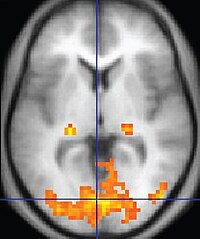
Photo from wikipedia
Purpose The aim of this study was to determine the relative abilities of compartment models to describe time‐courses of 18F‐fluoromisonidazole (FMISO) uptake in tumor voxels of patients with non‐small cell… Click to show full abstract
Purpose The aim of this study was to determine the relative abilities of compartment models to describe time‐courses of 18F‐fluoromisonidazole (FMISO) uptake in tumor voxels of patients with non‐small cell lung cancer (NSCLC) imaged using dynamic positron emission tomography. Also to use fits of the best‐performing model to investigate changes in fitted rate‐constants with distance from the tumor edge. Methods Reversible and irreversible two‐ and three‐tissue compartment models were fitted to 24 662 individual voxel time activity curves (TACs) obtained from tumors in nine patients, each imaged twice. Descriptions of the TACs provided by the models were compared using the Akaike and Bayesian information criteria (AIC and BIC). Two different models (two‐ and three‐tissue) were fitted to 30 measured voxel TACs to provide ground‐truth TACs for a statistical simulation study. Appropriately scaled noise was added to each of the resulting ground‐truth TACs, generating 1000 simulated noisy TACs for each ground‐truth TAC. The simulation study was carried out to provide estimates of the accuracy and precision with which parameter values are determined, the estimates being obtained for both assumptions about the ground‐truth kinetics. A BIC clustering technique was used to group the fitted rate‐constants, taking into consideration the underlying uncertainties on the fitted rate‐constants. Voxels were also categorized according to their distance from the tumor edge. Results For uptake time‐courses of individual voxels an irreversible two‐tissue compartment model was found to be most precise. The simulation study indicated that this model had a one standard deviation precision of 39% for tumor fractional blood volumes and 37% for the FMISO binding rate‐constant. Weighted means of fitted FMISO binding rate‐constants of voxels in all tumors rose significantly with increasing distance from the tumor edge, whereas fitted fractional blood volumes fell significantly. When grouped using the BIC clustering, many centrally located voxels had high‐fitted FMISO binding rate‐constants and low rate‐constants for tracer flow between the vasculature and tumor, both indicative of hypoxia. Nevertheless, many of these voxels had tumor‐to‐blood (TBR) values lower than the 1.4 level commonly expected for hypoxic tissues, possibly due to the low rate‐constants for tracer flow between the vasculature and tumor cells in these voxels. Conclusions Time‐courses of FMISO uptake in NSCLC tumor voxels are best analyzed using an irreversible two‐tissue compartment model, fits of which provide more precise parameter values than those of a three‐tissue model. Changes in fitted model parameter values indicate that levels of hypoxia rise with increasing distance from tumor edges. The average FMISO binding rate‐constant is higher for voxels in tumor centers than in the next tumor layer out, but the average value of the more simplistic TBR metric is lower in tumor centers. For both metrics, higher values might be considered indicative of hypoxia, and the mismatch in this case is likely to be due to poor perfusion at the tumor center. Kinetics analysis of dynamic PET images may therefore provide more accurate measures of the hypoxic status of such regions than the simpler TBR metric, a hypothesis we are presently exploring in a study of tumor imaging versus histopathology.
Journal Title: Medical Physics
Year Published: 2017
Link to full text (if available)
Share on Social Media: Sign Up to like & get
recommendations!